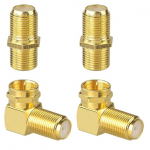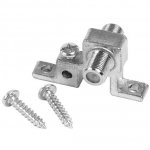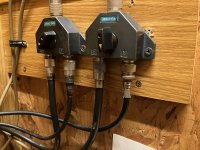ZaqHydN
Newbie
Using F-Connectors (Typical CATV connectors) with RG8/RG58 (50 ohm) Antenna Cable for RF Transmission.
I am installing a Thru-Wall Antenna Port in my apartment (with permission) for my Ham Rig.
I do not want to install a PL/SO connector type at the wall plate because they are large and uncommon.
I would rather install an F-Type Wall-Jack because they are smaller and when I move out, there isn't an odd-looking connector left behind.

F connectors are also much smaller and would make for a much cleaner installation as I plan on using a right-angle adaptor so the RF Line isn't sticking out from the wall.

Naturally, I would be making a custom cable that goes to the radio (PL/SO) to the F-type wall-jack.
The exterior connector will come from inside to an Exterior F-Block (easily grounded):

The exterior would also be using the same type of custom cable (F to PL/SO) to get from the insertion point to the antenna.
I know CATV coax (typical RG6/x) is 75ohm, but I will be using 50ohm RG8/x. Only the connectors for the Thru-Wall Setup would be the CATV type.
Knowing that every "connector/adaptor/jumper" inserted in a TX/RX line acts as a BalUn to some degree, I am curious as to what effects using F-Connectors would have in 50ohm TX/RX performance.
I have not heard of anyone using F-Connectors with Amateur Radio. I have also searched for information on this with no application-specific results. I only find information about coax and connectors, but not information about the actual application of using F Connectors in an 50ohm TX/RX Line.
My topic questions are:
A. Can the F-Connectors be used with a 50ohm system without a significant impact on TX/RX performance?
B. If you have had experience with using F-Connectors in an RF Transmission Line, what was the effect on your SWR/Power ratios?
Experimentally yours, N3LOY.
|----/-|
I am installing a Thru-Wall Antenna Port in my apartment (with permission) for my Ham Rig.
I do not want to install a PL/SO connector type at the wall plate because they are large and uncommon.
I would rather install an F-Type Wall-Jack because they are smaller and when I move out, there isn't an odd-looking connector left behind.

F connectors are also much smaller and would make for a much cleaner installation as I plan on using a right-angle adaptor so the RF Line isn't sticking out from the wall.

Naturally, I would be making a custom cable that goes to the radio (PL/SO) to the F-type wall-jack.
The exterior connector will come from inside to an Exterior F-Block (easily grounded):

The exterior would also be using the same type of custom cable (F to PL/SO) to get from the insertion point to the antenna.
I know CATV coax (typical RG6/x) is 75ohm, but I will be using 50ohm RG8/x. Only the connectors for the Thru-Wall Setup would be the CATV type.
Knowing that every "connector/adaptor/jumper" inserted in a TX/RX line acts as a BalUn to some degree, I am curious as to what effects using F-Connectors would have in 50ohm TX/RX performance.
I have not heard of anyone using F-Connectors with Amateur Radio. I have also searched for information on this with no application-specific results. I only find information about coax and connectors, but not information about the actual application of using F Connectors in an 50ohm TX/RX Line.
My topic questions are:
A. Can the F-Connectors be used with a 50ohm system without a significant impact on TX/RX performance?
B. If you have had experience with using F-Connectors in an RF Transmission Line, what was the effect on your SWR/Power ratios?
Experimentally yours, N3LOY.
|----/-|




